Performing Searches
Table of contents
Searches allow you to select elements from a layer using the attribute values of these elements. Once you have performed a search, you can review the attribute values of the selected elements and export the information to various formats.
Searches or queries performed in the application are found in the Search panel.
To perform a search, you must start by making the layer you are interested in selectable. Refer to Making layer elements selectable for the steps to do this.
The Search panel
The Search panel contains the searches that are available in the application.
-
Click on
 to open the Search panel. The icon changes color
to open the Search panel. The icon changes color  .
.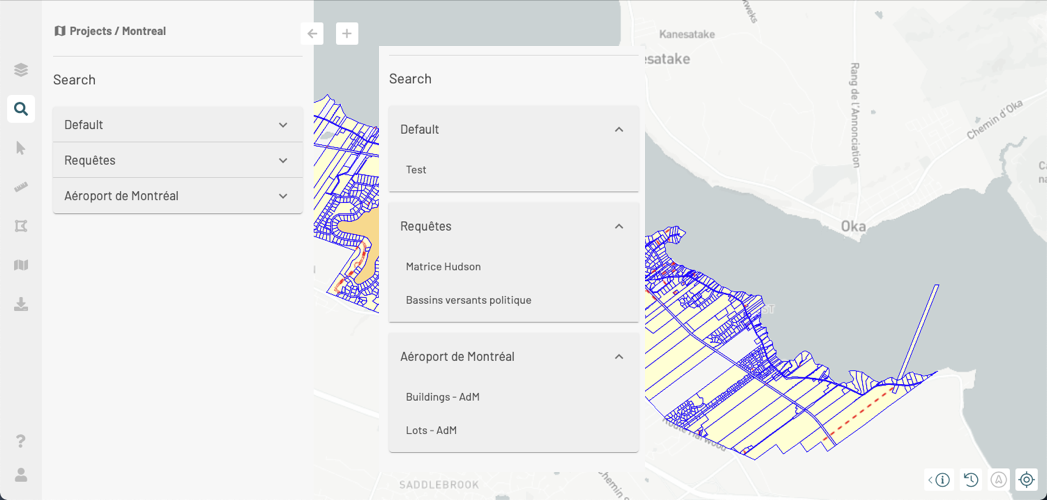
Groups of queries appear in the panel as cards. Groups can be open, displaying the queries, or closed, displaying only the name of the group.
-
In the card of a group, click on
 to open the group and display the searches it contains.
to open the group and display the searches it contains. -
Click on
 to close the group of queries.
to close the group of queries.
Performing a search
To perform a search:
-
Click on the search you are interested in to open the form in which the search terms can be entered.
-
Click on Back to close the search form and return to the Search panel.
-
Fill out the search form by selecting values in the drop-down lists or entering values in the text fields.
In the drop-down lists, you can speed up the search for the values you want by partially typing them in the filter field. The list only displays the values containing the characters you entered in the field. You must select the value by clicking on it.
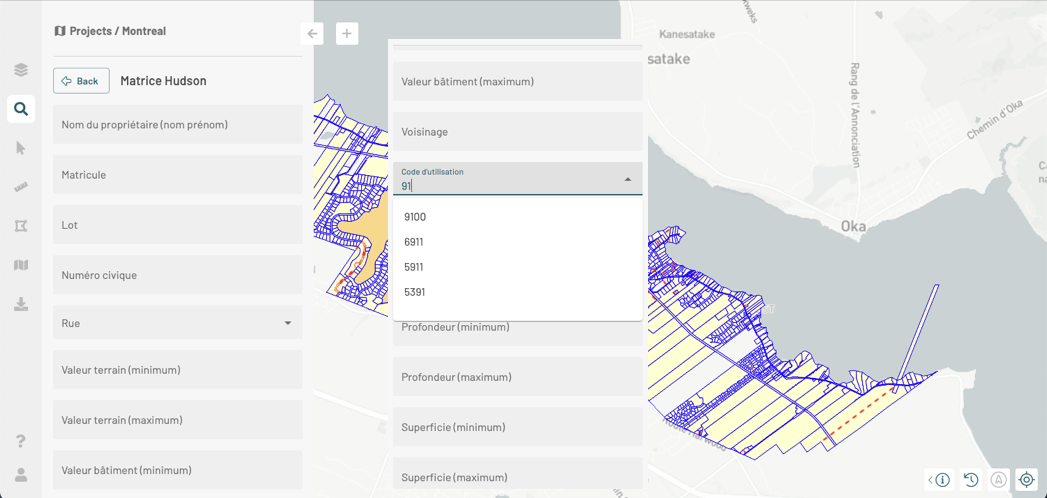
-
Click on Search to launch your search. The search results will be displayed. The following section describes the tools that allow you to work with the search results.
The search results
A search selects the layer elements whose attribute values match the terms you entered in the form. Several tools allow you to work with these elements.
The elements selected as search results will remain selected until they are unselected or until their layer is no longer selectable.
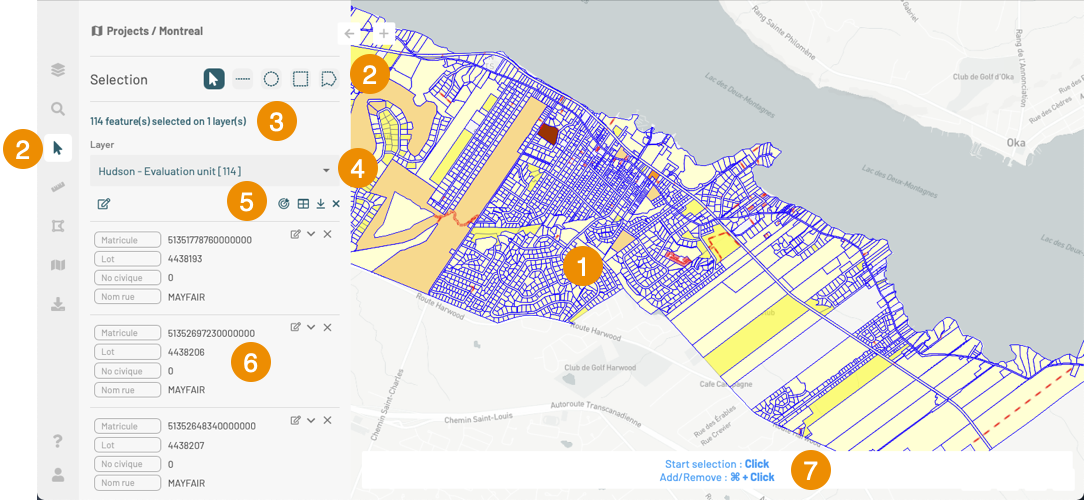
| 1 | The selected map objects or elements are indicated in yellow on the map. If you click on an element, it remains selected and the other elements are unselected. |
| 2 | Interactive selection tools are displayed in the panel. Refer to Interactive selection tools for a description of each tool. You can use them to select objects in the map. When you select objects in the map, the objects selected by the search are unselected. |
| 3 | This legend indicates the number of selected elements and the number of layers to which they belong. |
| 4 | The name of each layer with the number of selected elements is also displayed. |
| 5 | Several tools allow you to work with the selected elements: 1. Click on  to modify the selected elements. Refers to the section Editing Data for details about this topic. to modify the selected elements. Refers to the section Editing Data for details about this topic.2. Click on  to place all of the selected elements in the center of the map. The scale will change, and it is possible that the layer will no longer be visible. to place all of the selected elements in the center of the map. The scale will change, and it is possible that the layer will no longer be visible.2. Click on  to open a table displaying the attribute data of the selected elements. The icon will darken. The Data table section presents the details of this table. to open a table displaying the attribute data of the selected elements. The icon will darken. The Data table section presents the details of this table. 3. Click on  to close the data table. to close the data table.4. Click on  to download an Excel file containing the attributes of all selected elements. to download an Excel file containing the attributes of all selected elements.5. Click on  to unselect all of the elements. to unselect all of the elements. |
| 6 | For each selected element, a card displays the attribute values: 1. Use the mouse pointer to slide down the list of cards and browse it. There is one card for each selected element. 2. Click on an element’s card to place that element in the center of the map. Click on  to return to the previous view of the map. to return to the previous view of the map.3. Click on  to expand the card and display all of its attributes. to expand the card and display all of its attributes.4. Click on  to minimize the card. to minimize the card.5. Click on  to edit the element. Refers to the section Editing Data for details about this topic. to edit the element. Refers to the section Editing Data for details about this topic.6. Click on  to unselect the element. The other elements remain selected. to unselect the element. The other elements remain selected. |
| 7 | Instructions to help you select elements on the map. If you use the method described here, the elements selected using the search form will be unselected. |
Data table
The data table displays the attribute values of the selected elements in tabular form. The elements are listed in the table’s lines, and their attributes are shown in the columns.
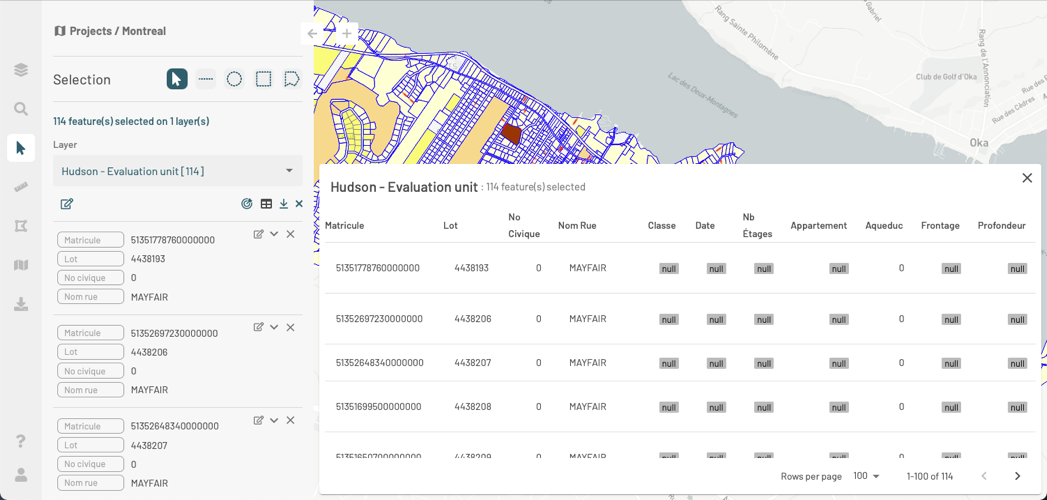
You can select the number of elements (or lines) to be displayed on each page.
-
Click on Rows per page to display the options.
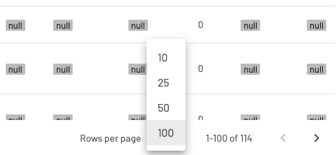
-
Select the desired option. The table will adjust to your choice.
-
Use the arrows to browse through the pages in the table.
You can sort the elements based on the values of a given attribute.
-
Hover the mouse pointer over the header of the column corresponding to the attribute you want to use to sort the data. An arrow
 displays next to the name of the attribute.
displays next to the name of the attribute. -
Click on the arrow
 to enable sorting. The arrow darkens
to enable sorting. The arrow darkens  and the elements are sorted in ascending order, based on their value for that attribute.
and the elements are sorted in ascending order, based on their value for that attribute. -
Click again to change the order. The arrow changes to
 and the elements are sorted in descending order.
and the elements are sorted in descending order.
You can also use the table to navigate between the selected elements:
-
Click on the line of an element in the table. That element is placed in the center of the map.
-
Click on
 to return to the previous view.
to return to the previous view.
Lastly, click on  to close the table. The elements remain selected.
to close the table. The elements remain selected.